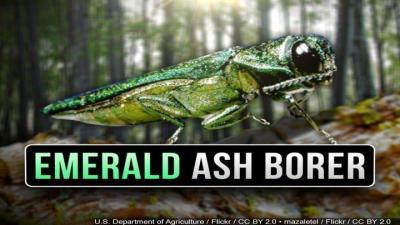Emerald Ash Borer Information
An emerald ash borer (EAB) infestation has been detected in Cannon Falls. The locations are visible on MDA’s EAB Status Map if you zoom into the area. Infested trees were identified by MDA staff traveling through the area.
Please look over MDA’s Guidelines to Slow the Growth and Spread of EAB if you haven’t before. The guidelines contain a wealth of information on how to deal with EAB and include example management plans from different cities around the state. More information for natural resource professionals can be found at https://www.mda.state.mn.us/eab-info-resource-professionals.
One of the most important things is making sure residents are aware that EAB is in the city and to begin making decisions on what they’d like to do with their ash trees. If residents want to save their ash trees, then they should begin having their trees treated with insecticide this spring/summer. More information for homeowners can be found at https://www.mda.state.mn.us/eab-info-homeowners.
The basic options for a property owner are the following:
- If the ash tree still looks healthy enough after leaf out (no more than 30% canopy decline), you can begin having it treated with insecticide to begin protecting it next spring/summer. This is an annual or biennial expense and best to have a certified arborist assess the health of the tree and apply the treatment. If the tree is over 15” in diameter at breast height it is important to have a licensed pesticide applicator treat the tree. The chemicals available to the average homeowner typically aren’t rated for trees that size or larger. Homeowners guide to insecticide selection
- If the tree is past the point of being a good candidate for treatment or would prefer not to go that route, plan to do removals during fall, winter or early spring. Try to avoid doing any pruning or removals during the summer months when EAB is actively flying around. Ash trees become very brittle and hazardous quickly after they die and that can greatly increase removal costs depending on where it happens to be located in the yard. It typically takes about 3 years for signs of infestation to become initially visible (i.e. woodpecker damage in branches 3-5 inches in diameter) and a total of 5-6 years for EAB to kill the tree.
- If the ash trees are in a natural area where they don’t pose hazards to persons or property, they can be left to die and fall apart.
- As for the wood, it is best if it can be kept as close to where it was cut as possible. You can save it for firewood and burn on-site if you have a fire pit, bring to closest tree waste disposal site, or have a tree care company haul it if you hire one to cut the tree. It is just important that the wood doesn’t get hauled outside of the known infested area and emerald ash borer quarantine restrictions are followed.

